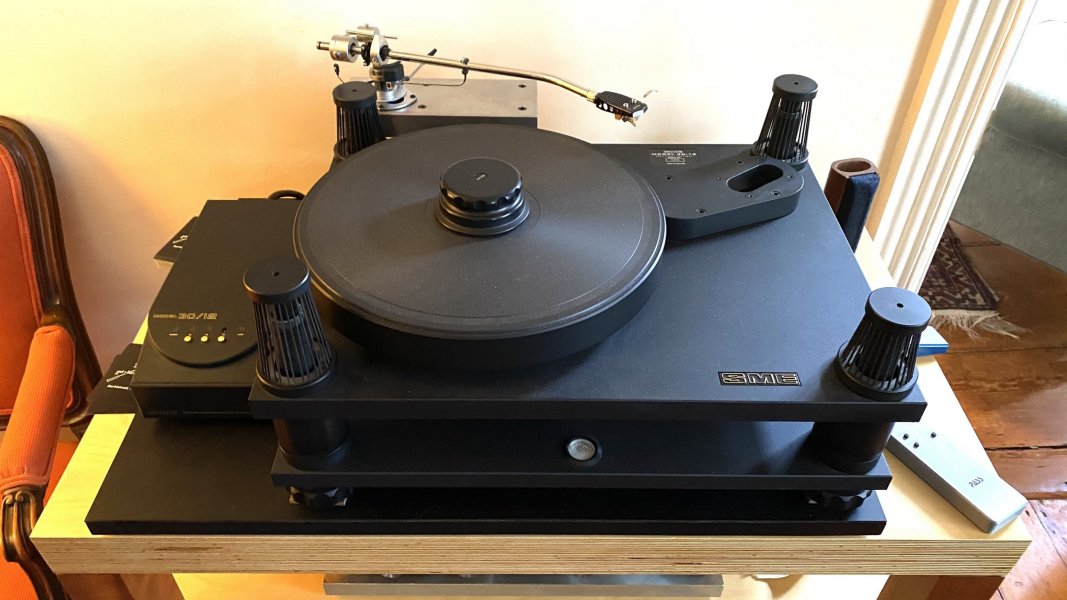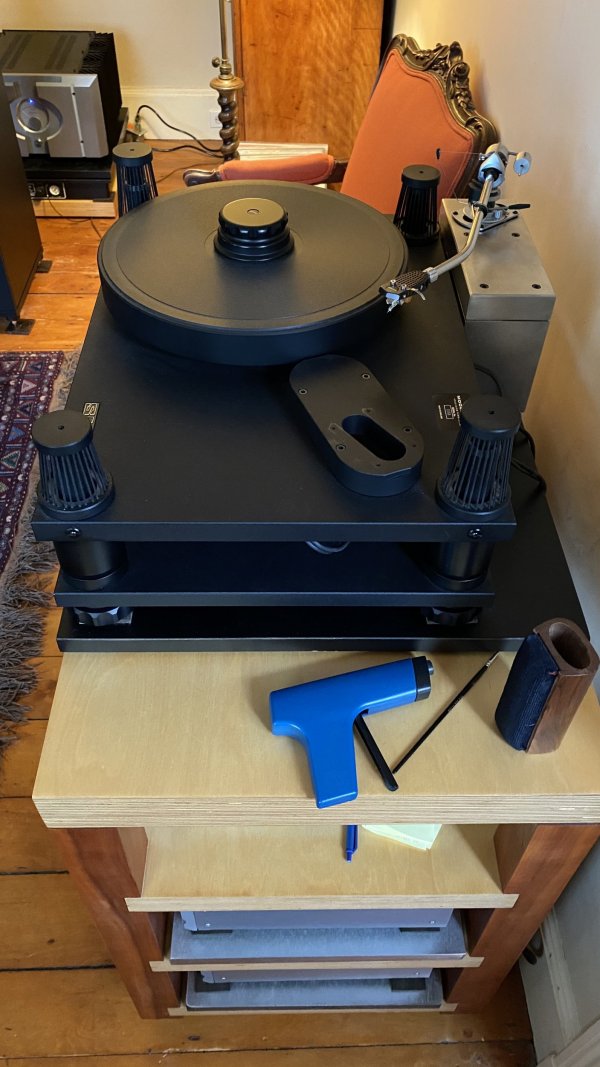IME with vdHs the exceptional resolution makes them the most "natural" cartridges I've come across and the most enjoyable to listen to.
david
And as always this will depend on the context of system and system set-up.
IME with vdHs the exceptional resolution makes them the most "natural" cartridges I've come across and the most enjoyable to listen to.
david
And as always this will depend on the context of system and system set-up.
Hmmm. I think the vdH's state of the art transparency and high resolution and "de-congestion" will manifest on any proper set-up.
I hear this too!
(This is why I find the vdH Grand Cru to be so maddening. Yes, the Grand Cru is the most uncongested, the most transparent, and the most resolving cartridge I've ever heard. But if I cannot relax and enjoy the music while I'm listening to it, why should I have it?)
Ron it isn’t that the aforementioned transparency/ high res and decongesting won’t manifest per se but whether the resulting system fit is balanced or actually too bright and skeletal for the taste of the end user.
@PeterA. I need to put this word down before I forget. The past two days I have been fine tuning my cart setups, the Opus1, MS and GC. The GC is now showing its great dna by the way. What I find the vdh does better than others that I have heard is it sounds so very "un-congested". So un-congested to the point it makes even the Opus1 which has greatest strength in area of dimensionality and space feel "congested" when listening big orchestra comparing to the vdh.
un-congested ... that's good Tang.
I like this term and found myself nodding my head to it when reading the above and thinking of descriptions of the vdH MS, particularly when listening to large orchestral music. My agreement was immediate, intuitive. Maybe I will use this word.
Then I asked myself, if I used 'uncongested' in a description of the Master Sig, would someone who has not heard the cartridge know what that description meant?
We do well with visual description and many of the same words and phrases we use for that we try to apply to sonic description, eg. coloration, transparency, etc. I find much of our attempt to describe sound is via connotation which is not explicit or literal, but implied or associative. It's worth saying that associations and implications may include a cultural factor, something usually not found with denotation.
The burden of un-something falls on that which it is not. Un-congested or uncongested depends on its reader having a notion of congested. I haven't heard the Opus 1 and until now I have not heard someone describe it as congested, however, per Tang it can feel (sound?) congested when playing big orchestra - when, and this may be important, compared to the vdH. Okay.
That's all good - so what do these words connote?
Tang mentions dimensionality and space, then @PeterA picks up on that saying "space is better with GC. Much more open too." So they find a quasi-visual connotation. I speculate most of use know that traffic can get congested - crowded, packed, choked, bunched up. There's fewer cars an hour after lunch, less congestion, etc. Look out an office window and see the congestion. etc. Pick another example of congested and see where uncongested takes that.
I'd like to take this a little beyond spatiality and dimension, a little beyond the visual.
We say big orchestral music because not only can the sound be big/large but because there often is a lot going on at once. Lot's of different instruments playing at the same time and often some of those instruments are in the same general frequency range. More of this from dense Brahms choral music going forward. Get into the likes of Tchaikovsky, Mahler, Shostakovich, etc. and we find eruptions of simultaneous multiple lower brass (horns, trombones, baritones, tubas), lower strings (bass and cellos), and percussion (cymbals, timpani, bass drum) , etc. Similar with large choral assembles with all voices singing at once.
Where I find the Master Sig uncongested - and here I want to switch from 'un-' to positive description - is its ability to follow multiple musical lines with clarity, definition and timbral naturalness, while maintaining the proper dynamics of each instrument as defined in the score. The better reveals why it is better. We may not grasp that the QRW cartridge is congested until we hear the VDH parse everything going on in the lower mids and upper bass and we hear and follow all the different lines from the rhythm section with greater timbral and dynamic clarity. Even when playing at the same frequency we can follow. I hear it when my focus is expanded to take in the music as a whole, or when I follow the basses or trombones. You, or at least I, get this in the concert hall and there the visuals confirm it (not cause it.) We might think of this as some form of instrument separation but imo it goes beyond spatial separation.
To me this un-congestion is one of the great strengths of the Master Sig.
Tim, even though I think “ un-congested“ is an interesting term or concept, I would prefer to describe the sound of the GC in terms of what it can do or positive attributes.
Where I find the Master Sig uncongested - and here I want to switch from 'un-' to positive description - is its ability to follow multiple musical lines with clarity, definition and timbral naturalness, while maintaining the proper dynamics of each instrument as defined in the score.
The extreme resolution or amount of information makes it easier to experience the sense of space and atmosphere in which the instruments are playing. The instruments themselves seem better defined and understood within that space. This is what I mean when I say there is a better sense of presence then there is with the opus (in my system). The music is simply more alive. The sound is cleaner, and there is more overall clarity. As important, I have the sense that the cartridge is adding or removing less than other cartridges to the sound, at least ones that I’ve heard in my system.
Up to a point Al, my comment was based on experience with a wide sampling of systems and as @Ron Resnick mentioned vdH’s qualities are audible on any low coloration system with reasonable resolution. Personal preference doesn’t change the nature of theses cartridges.And as always this will depend on the context of system and system set-up.


How much does SME charge?After nine years, it is time to send my SME V-12 back to England for a complete inspection, dismantling, repair, and rebuild. The internal wiring is worn and needs replacement. I am told that it will be returned in "AS NEW" condition. Turnaround time is 10-14 days once they receive it. Communication with SME is superb, and I expect the service to be the same. I consulted with the engineers about the design of my outboard armpod on which the SME 3012R is now located and sounding excellent.
I am now even more glad that I have a second tonearm so that I still have music. I had to relevel the platter as the weight of the V-12 now missing put the upper chassis out of balance.
View attachment 73968
View attachment 73969
How much does SME charge?
Maybe time to try out the factory position for the 3012R, just for the sake of comparison ?
Doesn't this call for a mounting of the SME 3012R on the table instead of the pod?After nine years, it is time to send my SME V-12 back to England for a complete inspection, dismantling, repair, and rebuild. The internal wiring is worn and needs replacement. I am told that it will be returned in "AS NEW" condition. Turnaround time is 10-14 days once they receive it. Communication with SME is superb, and I expect the service to be the same. I consulted with the engineers about the design of my outboard armpod on which the SME 3012R is now located and sounding excellent.
I am now even more glad that I have a second tonearm so that I still have music. I had to relevel the platter as the weight of the V-12 now missing put the upper chassis out of balance.
View attachment 73968
View attachment 73969
Doesn't this call for a mounting of the SME 3012R on the table instead of the pod?
Doesn't this call for a mounting of the SME 3012R on the table instead of the pod?
I read that further down when I caught up in this thread.The SME 3012R is not compatible with the SME30 turntable - the arm tube will touch the back of the pillar tower when playing. I managed to try mine because I also owned one SME3009R that is overall shorter.
This is a real pityI addressed that above. There is not enough clearance space between the arm counterweight and the suspension tower.
when the model 30 turntable came out, the engineers and Alastair were convinced the new magnesium tonearm sounded better so they offered these with the turntables as an integrated package And did not see the need to design the table to accommodate the old tonearms. This was confirmed to me by a great friend of Alastair Aikman Robinson’s.
| Steve Williams Site Founder | Site Owner | Administrator | Ron Resnick Site Owner | Administrator | Julian (The Fixer) Website Build | Marketing Managersing |

